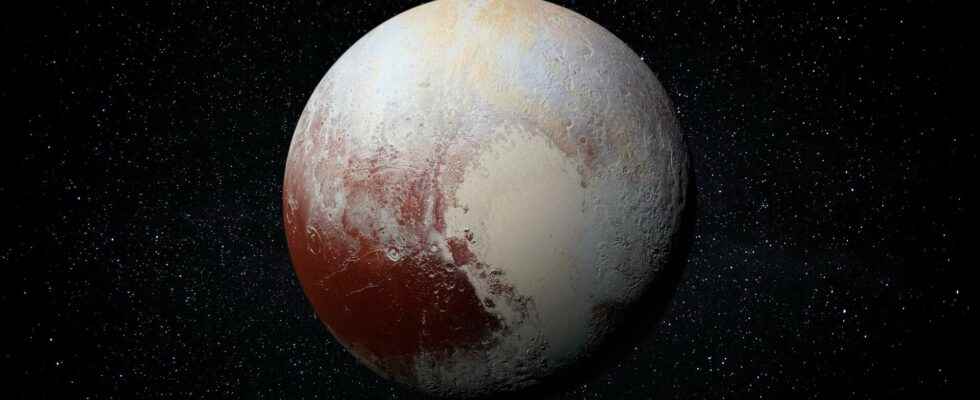Before the second half of the XXand century, the geologists and planetologists were far from suspecting the importance of volcanism in the Solar systemstarting with the Earth itself and its geodynamics controlled by the tectonic plates. Everything will change thanks to the development of theastronautics and in particular with the Travel missions who will make us discover the Io volcanismthe moon infernal of Jupiterand the cryovolcanism of Triton around Neptune. Today, we even wonder about possible eruptions underway on Venus and potential cryovolcanoes have even been detected on Titan, Saturn’s largest moon. In fact, there is now already a large body of work on volcanoes of the solar system as evidenced by the book Planetary Volcanism across the Solar System co-authored by Rosaly Lopezthe famous planetary scientist of the Nasa.
For several years, researchers have also wondered about the existence of volcanoes on the surface of Pluto but so far they had remained rather circumspect in examining the images provided by the mission new horizons in July 2015, during its only visit to the vicinity of the dwarf planet and its procession of moons.
What sources of heat for the volcanoes of the Solar System?
Indeed, it takes internal energy in the form of heat in a rocky celestial body to have volcanism, that the lavas issued are from basalt melted or a mixture of water,ammonia and methanol as it is believed to be in cryovolcanoes. For planets like Venus and the Earth, this warmth is a legacy of the process ofaccretion gravity and especially radioactive elements brought during accretion. They have therefore received a stock of energy that is all the more weak and which will be exhausted all the more quickly as the planet is small. It is for this reason that there does not seem to be any more volcanic activity on the Moon and Mercury for a long time already, even if we suspect that some eruptions are still possible in the case of the Moon.
In the case of Io and D’Enceladusthe moon of Saturn with geysersthey are thought to be tidal forces who heat these stars. This is not the case with Pluto today (except at the beginning of its history with the birth of its main moon, Charon) which, moreover, is smaller than the Moon. Logically, therefore, one would not expect to see significant volcanic or other activity on the surface of Pluto, which should therefore be dead and heavily cratered.
On this last point, it is certain that this is not the case as the images of the plain show Sputniknamed after the first artificial satellite, and which is a plain about 1,000 kilometers wide made up of ice ofnitrogenmethane and carbon monoxide. It is indeed relatively smooth and devoid of craters, to the point that it should probably only be less than 100 million years old. In addition, there is a polygonal structure that was first interpreted as a manifestation of cells of convection nitrogen/carbon monoxide ice. But recently this interpretation has been questioned..
An unprecedented cryovolcanism
A team of planetary scientists recently published an article in NatureCommunications where they explain that the images and data provided by new horizons strongly suggest that a region southwest of the Sputnik Plain does contain cryovolcanoes, but manifesting in a way never before seen when considering other known Solar System cryovolcanoes. However, this is not the first time that the existence of this phenomenon on Pluto has been considered..
This region had already attracted the attention of researchers in 2015 because it seemed very different from the others and since then analyzes of the images and the topography it revealed had continued. According to planetary scientists, other geological processes demonstrated that cryovolcanoes to create the observed features are unlikely. For example, the area has significant variations between the heights of the ups and downs of the terrain that could not have been created by erosion.
Data on the chemical composition of the intriguing structures detected suggest that they are mostly water ice. But, given the average temperature of Pluto, about 40 kelvins (-233°C), even taking into account a small additional component with ammonia or methanol, the supposed cryovolcanoes should not be able to emit liquid water and the visible flows should rather be similar to those of the glaciersalthough it is indeed a question of movements of matter analogous to those of liquid lava spewed out by volcanoes.
This is enough to revive speculation on the exact sources of energy that make Pluto a still living celestial body.
” One of the benefits of exploring new places in the Solar System is that we find things we didn’t expect. These giant, eerie cryovolcanoes observed by New Horizons are a great example of how we’re expanding our knowledge of volcanic processes and geological activity on icy worlds. », explained Kelsi Singer, assistant scientist of the project new horizons from Southwest Research InstituteBoulder, Colorado, and senior author of the published article.
Support your independent scientific media: discover our subscription formulas!
4 good reasons to subscribe to Futura on Patreon:
- A site without any advertising from 3.29 euros per month.
- It is without commitment.
- Access to priority content, in preview, just for you.
- You support our business in the best possible way. A real motivation for us!
Interested in what you just read?
